Research Proposal: HSE Impact in Netherlands' Downstream Oil & Gas
VerifiedAdded on 2023/05/29
|18
|3962
|246
Report
AI Summary
This research proposal critically analyzes the impact of the downstream sector in oil and gas production on health, safety, and the environment in the Netherlands. It identifies issues faced by workers, the impact of harmful gases, and aims to improve health and safety standards. The research objectives include assessing the impact of downstream activities on worker and community health and safety, examining the effects of oil and gas operations on worker safety, and evaluating the environmental impact. The proposal includes a literature review of the downstream sector, challenges, safety concerns, and the Netherlands' oil and gas industry, along with a methodology outlining the research philosophy, approach, strategy, data collection, and ethical considerations. Desklib provides access to similar research papers and solved assignments for students.
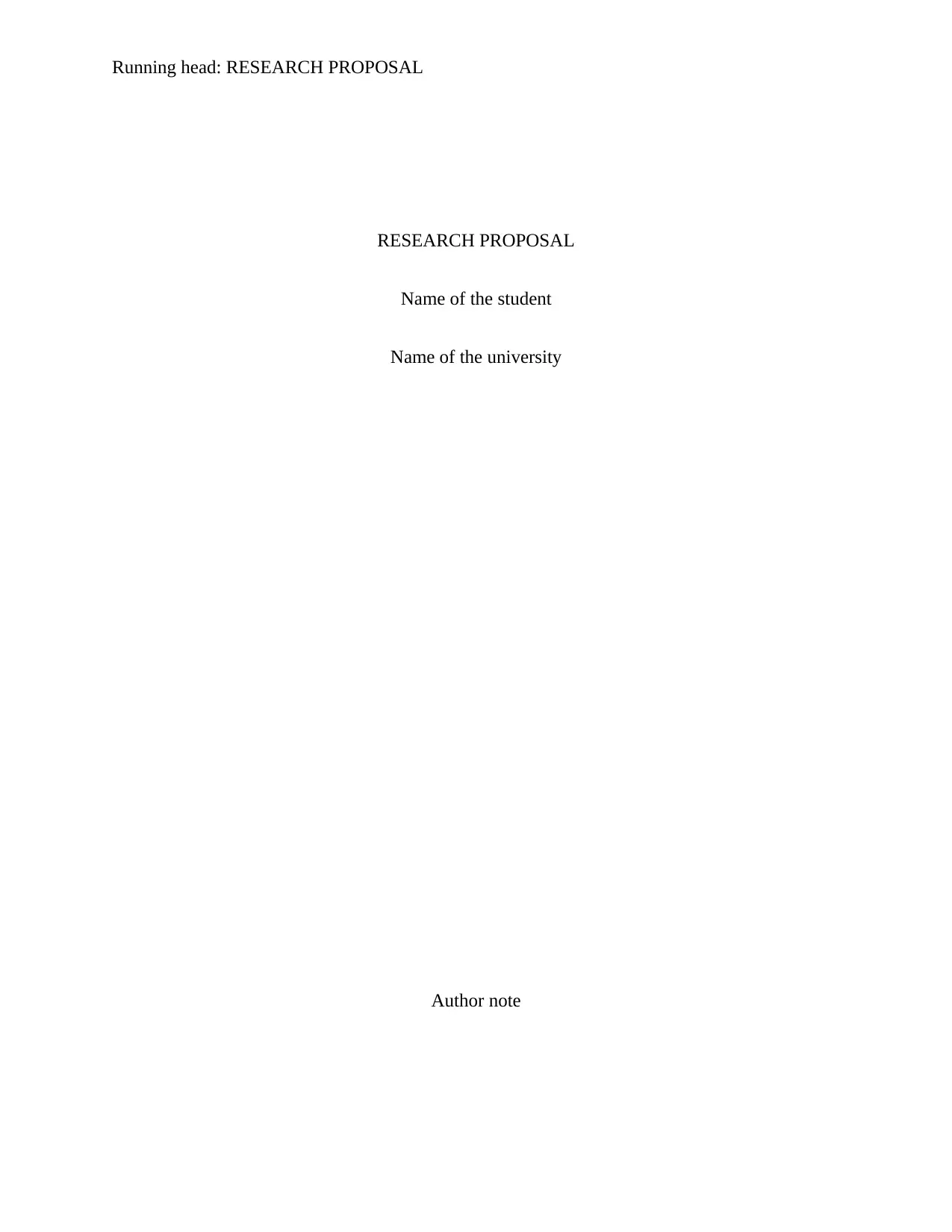
Running head: RESEARCH PROPOSAL
RESEARCH PROPOSAL
Name of the student
Name of the university
Author note
RESEARCH PROPOSAL
Name of the student
Name of the university
Author note
Paraphrase This Document
Need a fresh take? Get an instant paraphrase of this document with our AI Paraphraser
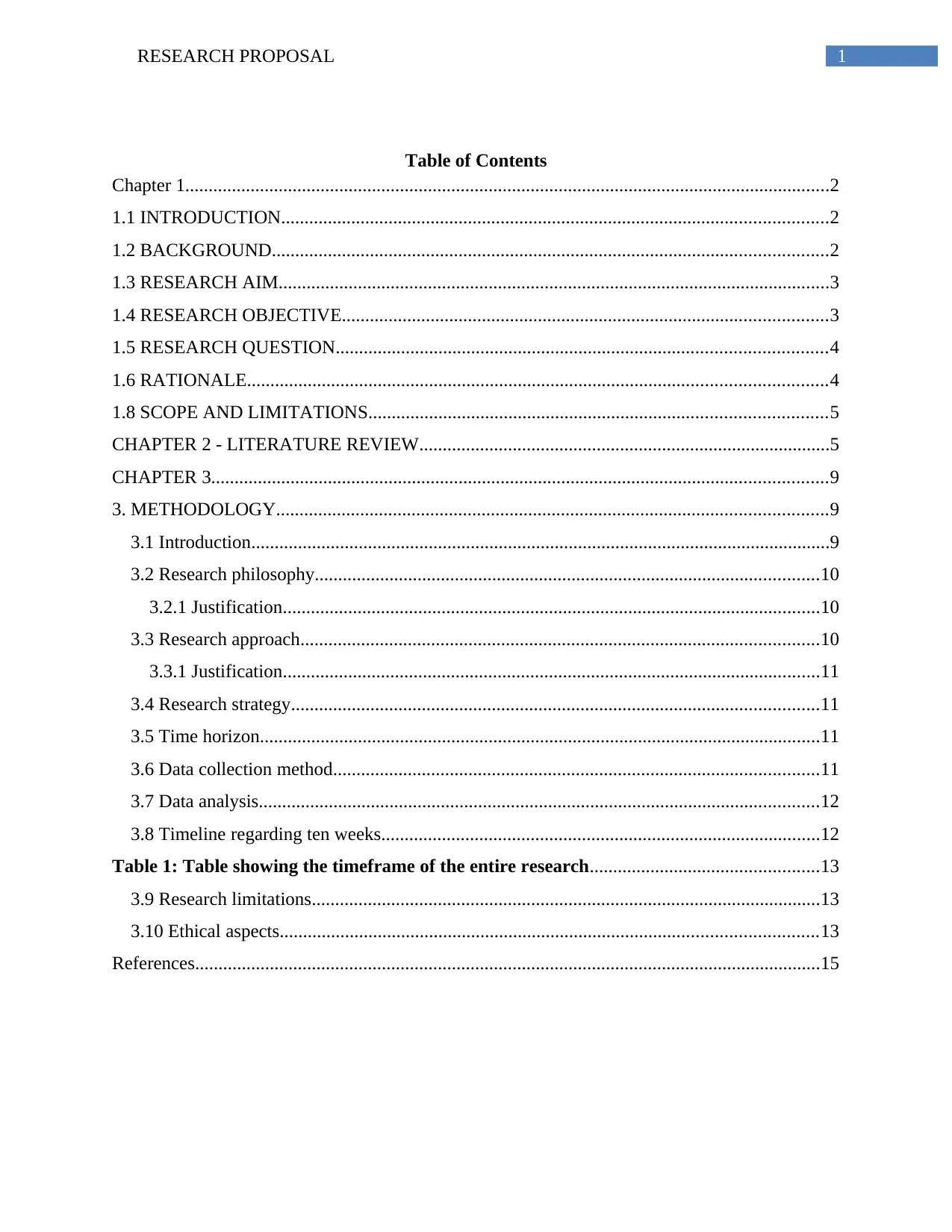
1RESEARCH PROPOSAL
Table of Contents
Chapter 1..........................................................................................................................................2
1.1 INTRODUCTION.....................................................................................................................2
1.2 BACKGROUND.......................................................................................................................2
1.3 RESEARCH AIM......................................................................................................................3
1.4 RESEARCH OBJECTIVE........................................................................................................3
1.5 RESEARCH QUESTION.........................................................................................................4
1.6 RATIONALE............................................................................................................................4
1.8 SCOPE AND LIMITATIONS..................................................................................................5
CHAPTER 2 - LITERATURE REVIEW........................................................................................5
CHAPTER 3....................................................................................................................................9
3. METHODOLOGY......................................................................................................................9
3.1 Introduction............................................................................................................................9
3.2 Research philosophy............................................................................................................10
3.2.1 Justification...................................................................................................................10
3.3 Research approach...............................................................................................................10
3.3.1 Justification...................................................................................................................11
3.4 Research strategy.................................................................................................................11
3.5 Time horizon........................................................................................................................11
3.6 Data collection method........................................................................................................11
3.7 Data analysis........................................................................................................................12
3.8 Timeline regarding ten weeks..............................................................................................12
Table 1: Table showing the timeframe of the entire research.................................................13
3.9 Research limitations.............................................................................................................13
3.10 Ethical aspects...................................................................................................................13
References......................................................................................................................................15
Table of Contents
Chapter 1..........................................................................................................................................2
1.1 INTRODUCTION.....................................................................................................................2
1.2 BACKGROUND.......................................................................................................................2
1.3 RESEARCH AIM......................................................................................................................3
1.4 RESEARCH OBJECTIVE........................................................................................................3
1.5 RESEARCH QUESTION.........................................................................................................4
1.6 RATIONALE............................................................................................................................4
1.8 SCOPE AND LIMITATIONS..................................................................................................5
CHAPTER 2 - LITERATURE REVIEW........................................................................................5
CHAPTER 3....................................................................................................................................9
3. METHODOLOGY......................................................................................................................9
3.1 Introduction............................................................................................................................9
3.2 Research philosophy............................................................................................................10
3.2.1 Justification...................................................................................................................10
3.3 Research approach...............................................................................................................10
3.3.1 Justification...................................................................................................................11
3.4 Research strategy.................................................................................................................11
3.5 Time horizon........................................................................................................................11
3.6 Data collection method........................................................................................................11
3.7 Data analysis........................................................................................................................12
3.8 Timeline regarding ten weeks..............................................................................................12
Table 1: Table showing the timeframe of the entire research.................................................13
3.9 Research limitations.............................................................................................................13
3.10 Ethical aspects...................................................................................................................13
References......................................................................................................................................15
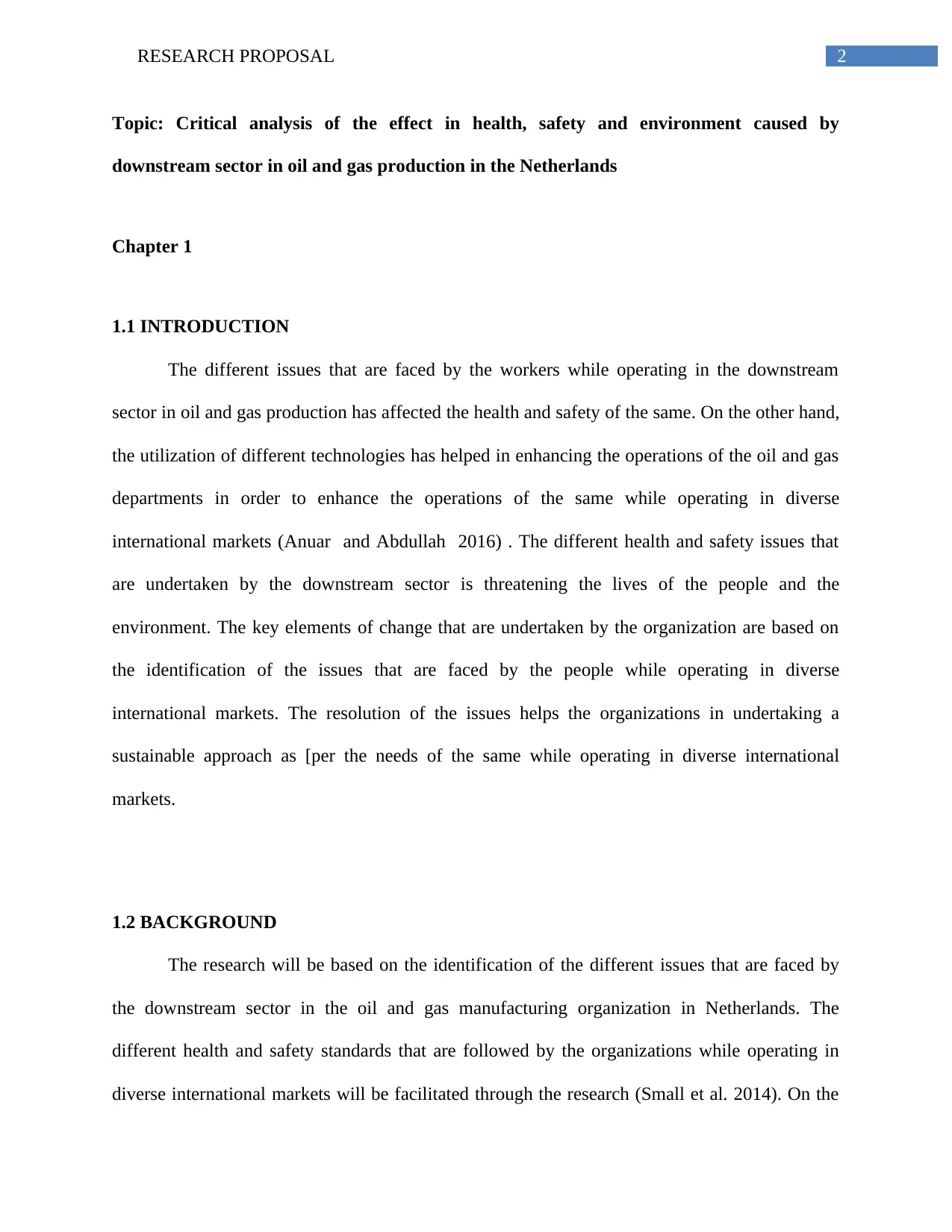
2RESEARCH PROPOSAL
Topic: Critical analysis of the effect in health, safety and environment caused by
downstream sector in oil and gas production in the Netherlands
Chapter 1
1.1 INTRODUCTION
The different issues that are faced by the workers while operating in the downstream
sector in oil and gas production has affected the health and safety of the same. On the other hand,
the utilization of different technologies has helped in enhancing the operations of the oil and gas
departments in order to enhance the operations of the same while operating in diverse
international markets (Anuar and Abdullah 2016) . The different health and safety issues that
are undertaken by the downstream sector is threatening the lives of the people and the
environment. The key elements of change that are undertaken by the organization are based on
the identification of the issues that are faced by the people while operating in diverse
international markets. The resolution of the issues helps the organizations in undertaking a
sustainable approach as [per the needs of the same while operating in diverse international
markets.
1.2 BACKGROUND
The research will be based on the identification of the different issues that are faced by
the downstream sector in the oil and gas manufacturing organization in Netherlands. The
different health and safety standards that are followed by the organizations while operating in
diverse international markets will be facilitated through the research (Small et al. 2014). On the
Topic: Critical analysis of the effect in health, safety and environment caused by
downstream sector in oil and gas production in the Netherlands
Chapter 1
1.1 INTRODUCTION
The different issues that are faced by the workers while operating in the downstream
sector in oil and gas production has affected the health and safety of the same. On the other hand,
the utilization of different technologies has helped in enhancing the operations of the oil and gas
departments in order to enhance the operations of the same while operating in diverse
international markets (Anuar and Abdullah 2016) . The different health and safety issues that
are undertaken by the downstream sector is threatening the lives of the people and the
environment. The key elements of change that are undertaken by the organization are based on
the identification of the issues that are faced by the people while operating in diverse
international markets. The resolution of the issues helps the organizations in undertaking a
sustainable approach as [per the needs of the same while operating in diverse international
markets.
1.2 BACKGROUND
The research will be based on the identification of the different issues that are faced by
the downstream sector in the oil and gas manufacturing organization in Netherlands. The
different health and safety standards that are followed by the organizations while operating in
diverse international markets will be facilitated through the research (Small et al. 2014). On the
⊘ This is a preview!⊘
Do you want full access?
Subscribe today to unlock all pages.

Trusted by 1+ million students worldwide
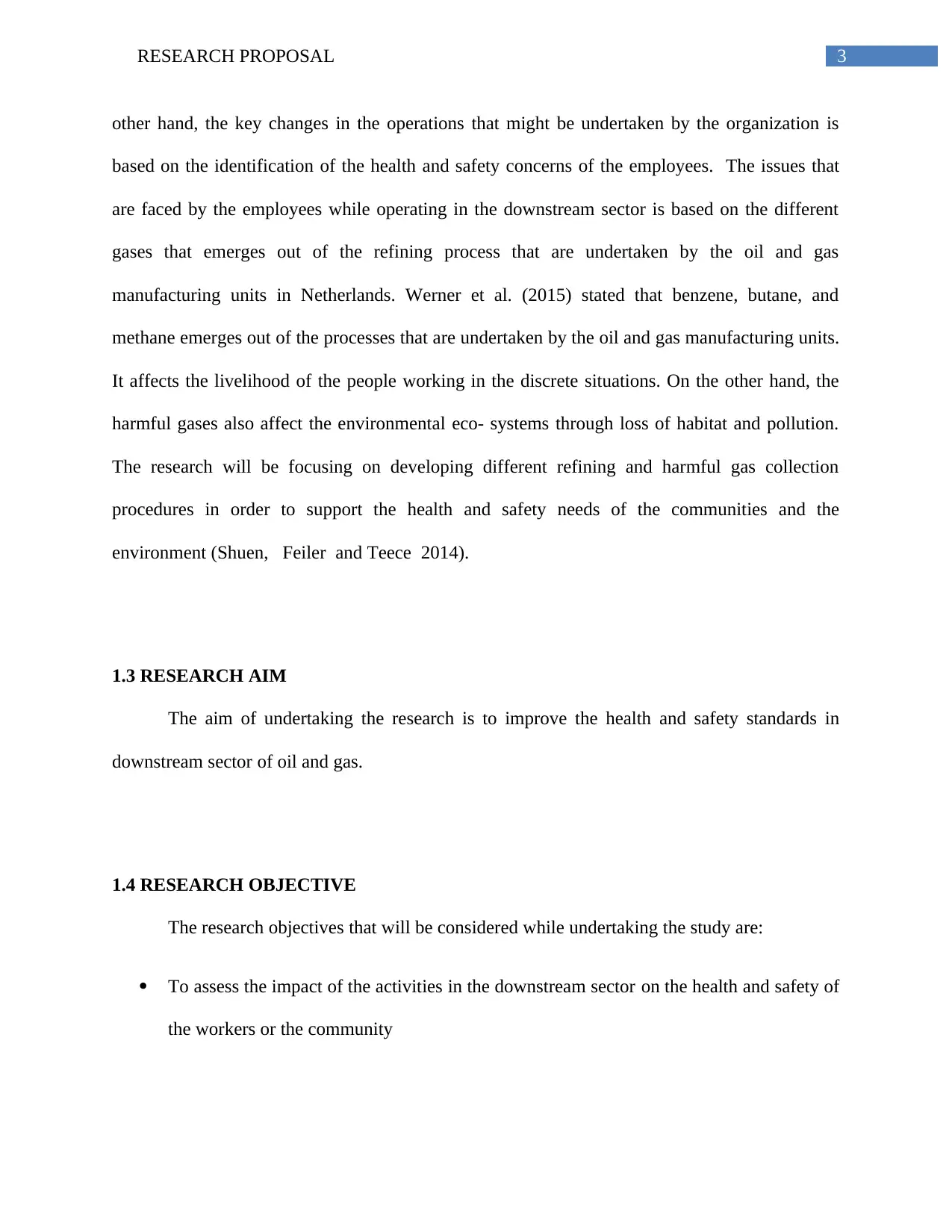
3RESEARCH PROPOSAL
other hand, the key changes in the operations that might be undertaken by the organization is
based on the identification of the health and safety concerns of the employees. The issues that
are faced by the employees while operating in the downstream sector is based on the different
gases that emerges out of the refining process that are undertaken by the oil and gas
manufacturing units in Netherlands. Werner et al. (2015) stated that benzene, butane, and
methane emerges out of the processes that are undertaken by the oil and gas manufacturing units.
It affects the livelihood of the people working in the discrete situations. On the other hand, the
harmful gases also affect the environmental eco- systems through loss of habitat and pollution.
The research will be focusing on developing different refining and harmful gas collection
procedures in order to support the health and safety needs of the communities and the
environment (Shuen, Feiler and Teece 2014).
1.3 RESEARCH AIM
The aim of undertaking the research is to improve the health and safety standards in
downstream sector of oil and gas.
1.4 RESEARCH OBJECTIVE
The research objectives that will be considered while undertaking the study are:
To assess the impact of the activities in the downstream sector on the health and safety of
the workers or the community
other hand, the key changes in the operations that might be undertaken by the organization is
based on the identification of the health and safety concerns of the employees. The issues that
are faced by the employees while operating in the downstream sector is based on the different
gases that emerges out of the refining process that are undertaken by the oil and gas
manufacturing units in Netherlands. Werner et al. (2015) stated that benzene, butane, and
methane emerges out of the processes that are undertaken by the oil and gas manufacturing units.
It affects the livelihood of the people working in the discrete situations. On the other hand, the
harmful gases also affect the environmental eco- systems through loss of habitat and pollution.
The research will be focusing on developing different refining and harmful gas collection
procedures in order to support the health and safety needs of the communities and the
environment (Shuen, Feiler and Teece 2014).
1.3 RESEARCH AIM
The aim of undertaking the research is to improve the health and safety standards in
downstream sector of oil and gas.
1.4 RESEARCH OBJECTIVE
The research objectives that will be considered while undertaking the study are:
To assess the impact of the activities in the downstream sector on the health and safety of
the workers or the community
Paraphrase This Document
Need a fresh take? Get an instant paraphrase of this document with our AI Paraphraser
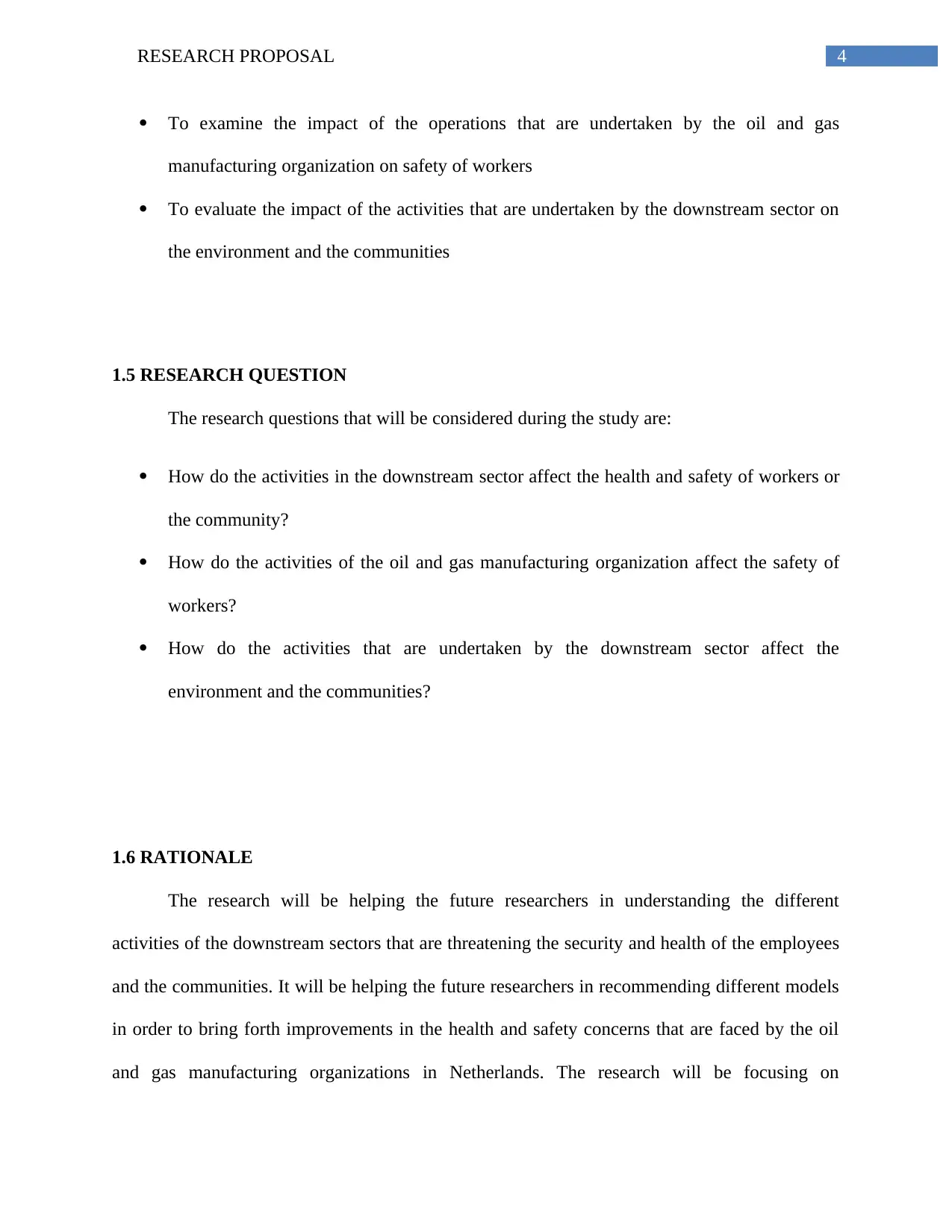
4RESEARCH PROPOSAL
To examine the impact of the operations that are undertaken by the oil and gas
manufacturing organization on safety of workers
To evaluate the impact of the activities that are undertaken by the downstream sector on
the environment and the communities
1.5 RESEARCH QUESTION
The research questions that will be considered during the study are:
How do the activities in the downstream sector affect the health and safety of workers or
the community?
How do the activities of the oil and gas manufacturing organization affect the safety of
workers?
How do the activities that are undertaken by the downstream sector affect the
environment and the communities?
1.6 RATIONALE
The research will be helping the future researchers in understanding the different
activities of the downstream sectors that are threatening the security and health of the employees
and the communities. It will be helping the future researchers in recommending different models
in order to bring forth improvements in the health and safety concerns that are faced by the oil
and gas manufacturing organizations in Netherlands. The research will be focusing on
To examine the impact of the operations that are undertaken by the oil and gas
manufacturing organization on safety of workers
To evaluate the impact of the activities that are undertaken by the downstream sector on
the environment and the communities
1.5 RESEARCH QUESTION
The research questions that will be considered during the study are:
How do the activities in the downstream sector affect the health and safety of workers or
the community?
How do the activities of the oil and gas manufacturing organization affect the safety of
workers?
How do the activities that are undertaken by the downstream sector affect the
environment and the communities?
1.6 RATIONALE
The research will be helping the future researchers in understanding the different
activities of the downstream sectors that are threatening the security and health of the employees
and the communities. It will be helping the future researchers in recommending different models
in order to bring forth improvements in the health and safety concerns that are faced by the oil
and gas manufacturing organizations in Netherlands. The research will be focusing on
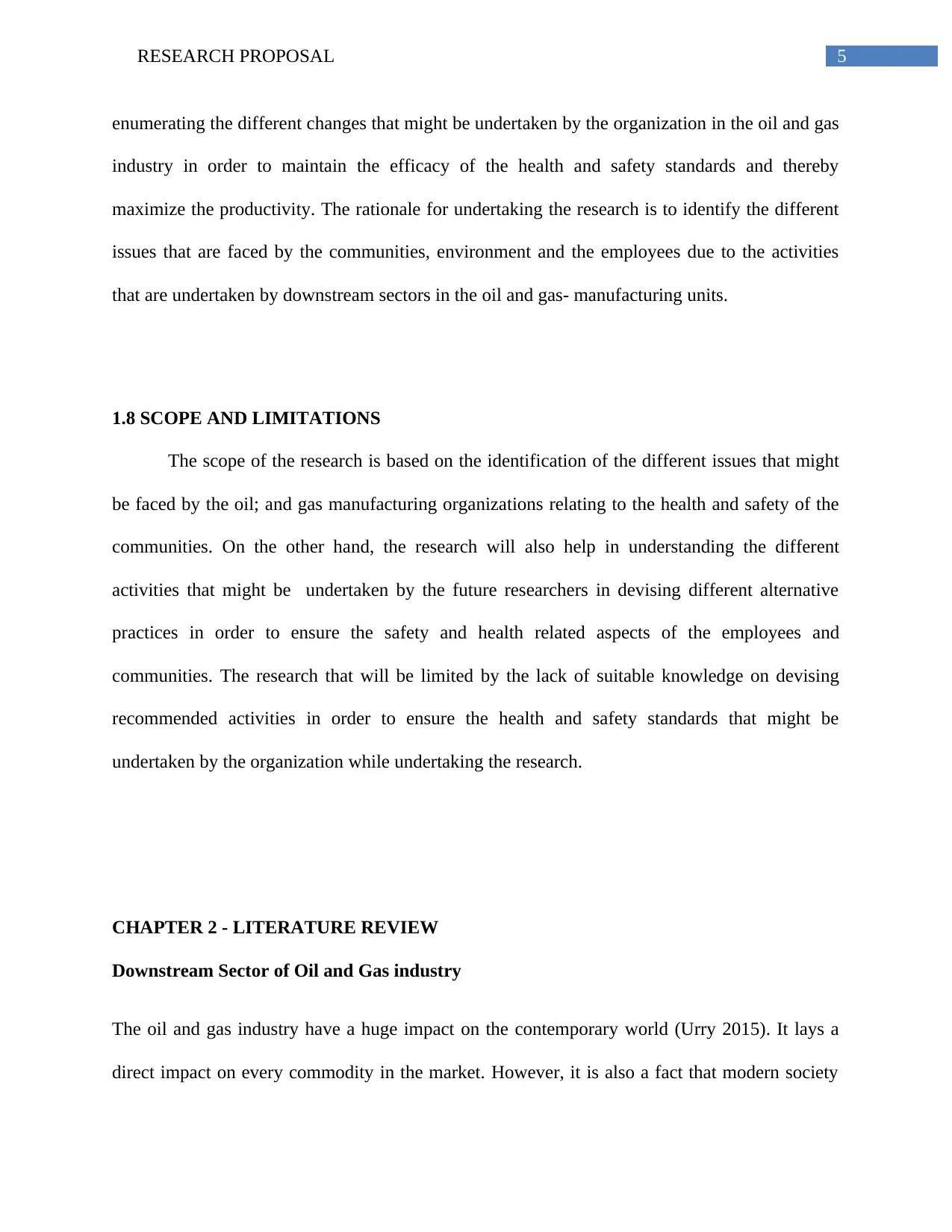
5RESEARCH PROPOSAL
enumerating the different changes that might be undertaken by the organization in the oil and gas
industry in order to maintain the efficacy of the health and safety standards and thereby
maximize the productivity. The rationale for undertaking the research is to identify the different
issues that are faced by the communities, environment and the employees due to the activities
that are undertaken by downstream sectors in the oil and gas- manufacturing units.
1.8 SCOPE AND LIMITATIONS
The scope of the research is based on the identification of the different issues that might
be faced by the oil; and gas manufacturing organizations relating to the health and safety of the
communities. On the other hand, the research will also help in understanding the different
activities that might be undertaken by the future researchers in devising different alternative
practices in order to ensure the safety and health related aspects of the employees and
communities. The research that will be limited by the lack of suitable knowledge on devising
recommended activities in order to ensure the health and safety standards that might be
undertaken by the organization while undertaking the research.
CHAPTER 2 - LITERATURE REVIEW
Downstream Sector of Oil and Gas industry
The oil and gas industry have a huge impact on the contemporary world (Urry 2015). It lays a
direct impact on every commodity in the market. However, it is also a fact that modern society
enumerating the different changes that might be undertaken by the organization in the oil and gas
industry in order to maintain the efficacy of the health and safety standards and thereby
maximize the productivity. The rationale for undertaking the research is to identify the different
issues that are faced by the communities, environment and the employees due to the activities
that are undertaken by downstream sectors in the oil and gas- manufacturing units.
1.8 SCOPE AND LIMITATIONS
The scope of the research is based on the identification of the different issues that might
be faced by the oil; and gas manufacturing organizations relating to the health and safety of the
communities. On the other hand, the research will also help in understanding the different
activities that might be undertaken by the future researchers in devising different alternative
practices in order to ensure the safety and health related aspects of the employees and
communities. The research that will be limited by the lack of suitable knowledge on devising
recommended activities in order to ensure the health and safety standards that might be
undertaken by the organization while undertaking the research.
CHAPTER 2 - LITERATURE REVIEW
Downstream Sector of Oil and Gas industry
The oil and gas industry have a huge impact on the contemporary world (Urry 2015). It lays a
direct impact on every commodity in the market. However, it is also a fact that modern society
⊘ This is a preview!⊘
Do you want full access?
Subscribe today to unlock all pages.

Trusted by 1+ million students worldwide
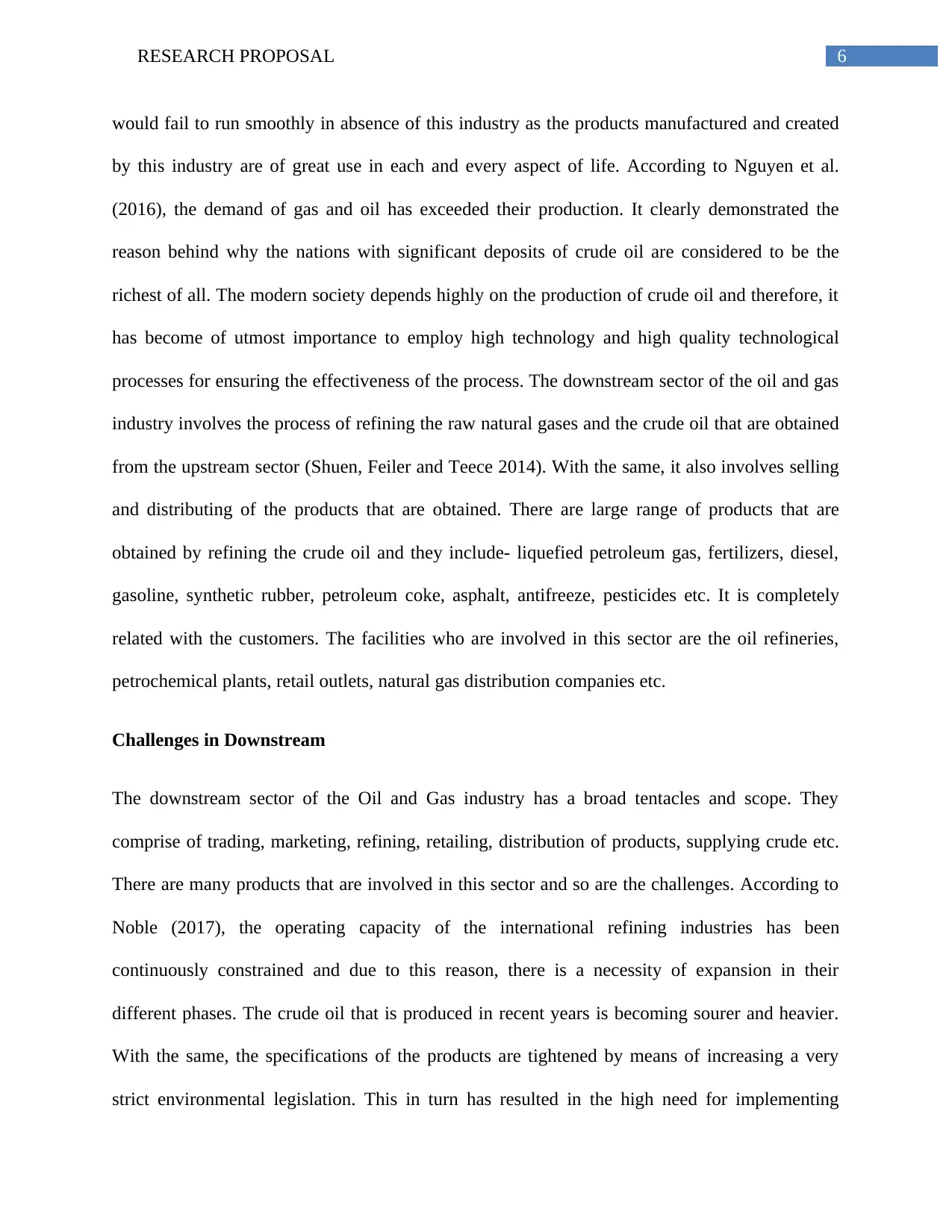
6RESEARCH PROPOSAL
would fail to run smoothly in absence of this industry as the products manufactured and created
by this industry are of great use in each and every aspect of life. According to Nguyen et al.
(2016), the demand of gas and oil has exceeded their production. It clearly demonstrated the
reason behind why the nations with significant deposits of crude oil are considered to be the
richest of all. The modern society depends highly on the production of crude oil and therefore, it
has become of utmost importance to employ high technology and high quality technological
processes for ensuring the effectiveness of the process. The downstream sector of the oil and gas
industry involves the process of refining the raw natural gases and the crude oil that are obtained
from the upstream sector (Shuen, Feiler and Teece 2014). With the same, it also involves selling
and distributing of the products that are obtained. There are large range of products that are
obtained by refining the crude oil and they include- liquefied petroleum gas, fertilizers, diesel,
gasoline, synthetic rubber, petroleum coke, asphalt, antifreeze, pesticides etc. It is completely
related with the customers. The facilities who are involved in this sector are the oil refineries,
petrochemical plants, retail outlets, natural gas distribution companies etc.
Challenges in Downstream
The downstream sector of the Oil and Gas industry has a broad tentacles and scope. They
comprise of trading, marketing, refining, retailing, distribution of products, supplying crude etc.
There are many products that are involved in this sector and so are the challenges. According to
Noble (2017), the operating capacity of the international refining industries has been
continuously constrained and due to this reason, there is a necessity of expansion in their
different phases. The crude oil that is produced in recent years is becoming sourer and heavier.
With the same, the specifications of the products are tightened by means of increasing a very
strict environmental legislation. This in turn has resulted in the high need for implementing
would fail to run smoothly in absence of this industry as the products manufactured and created
by this industry are of great use in each and every aspect of life. According to Nguyen et al.
(2016), the demand of gas and oil has exceeded their production. It clearly demonstrated the
reason behind why the nations with significant deposits of crude oil are considered to be the
richest of all. The modern society depends highly on the production of crude oil and therefore, it
has become of utmost importance to employ high technology and high quality technological
processes for ensuring the effectiveness of the process. The downstream sector of the oil and gas
industry involves the process of refining the raw natural gases and the crude oil that are obtained
from the upstream sector (Shuen, Feiler and Teece 2014). With the same, it also involves selling
and distributing of the products that are obtained. There are large range of products that are
obtained by refining the crude oil and they include- liquefied petroleum gas, fertilizers, diesel,
gasoline, synthetic rubber, petroleum coke, asphalt, antifreeze, pesticides etc. It is completely
related with the customers. The facilities who are involved in this sector are the oil refineries,
petrochemical plants, retail outlets, natural gas distribution companies etc.
Challenges in Downstream
The downstream sector of the Oil and Gas industry has a broad tentacles and scope. They
comprise of trading, marketing, refining, retailing, distribution of products, supplying crude etc.
There are many products that are involved in this sector and so are the challenges. According to
Noble (2017), the operating capacity of the international refining industries has been
continuously constrained and due to this reason, there is a necessity of expansion in their
different phases. The crude oil that is produced in recent years is becoming sourer and heavier.
With the same, the specifications of the products are tightened by means of increasing a very
strict environmental legislation. This in turn has resulted in the high need for implementing
Paraphrase This Document
Need a fresh take? Get an instant paraphrase of this document with our AI Paraphraser
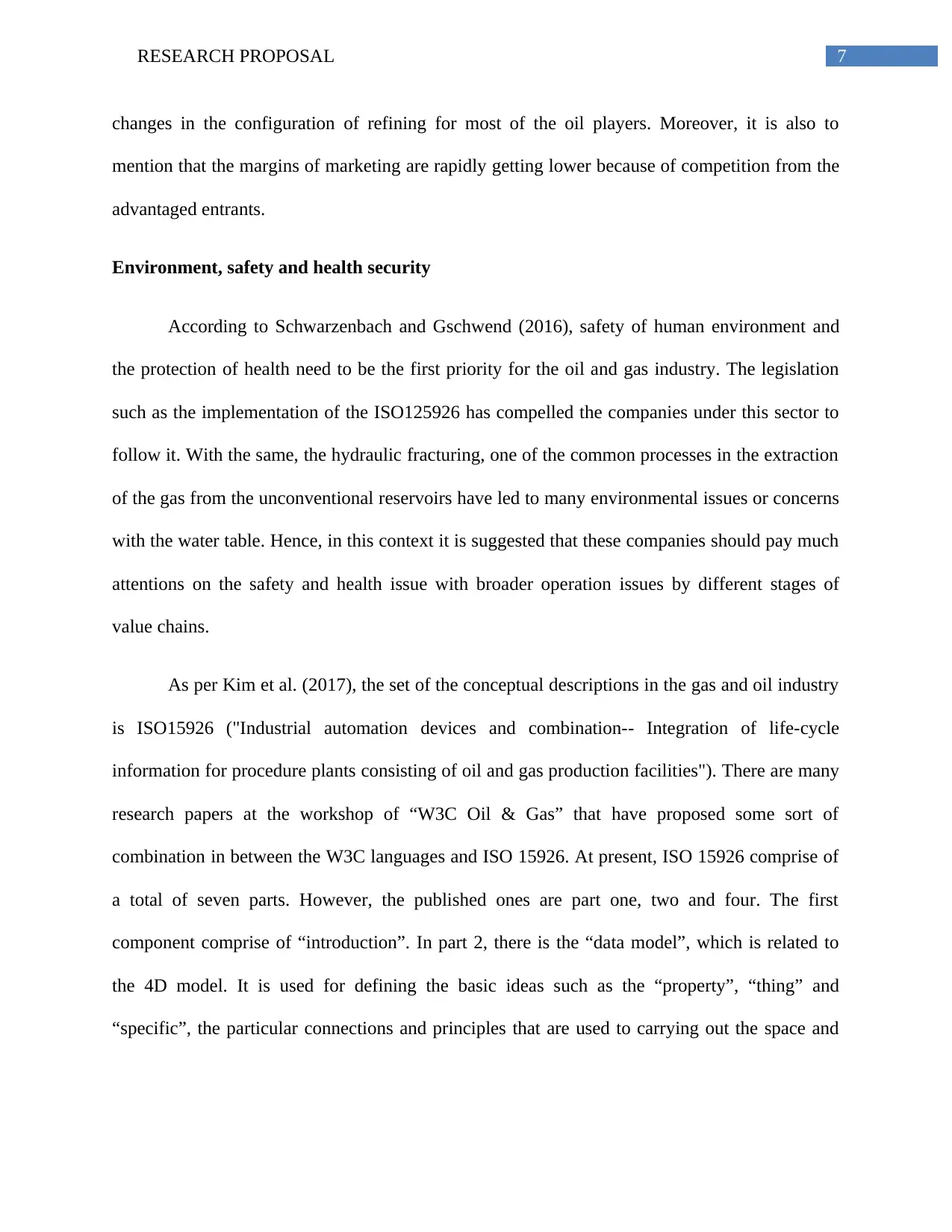
7RESEARCH PROPOSAL
changes in the configuration of refining for most of the oil players. Moreover, it is also to
mention that the margins of marketing are rapidly getting lower because of competition from the
advantaged entrants.
Environment, safety and health security
According to Schwarzenbach and Gschwend (2016), safety of human environment and
the protection of health need to be the first priority for the oil and gas industry. The legislation
such as the implementation of the ISO125926 has compelled the companies under this sector to
follow it. With the same, the hydraulic fracturing, one of the common processes in the extraction
of the gas from the unconventional reservoirs have led to many environmental issues or concerns
with the water table. Hence, in this context it is suggested that these companies should pay much
attentions on the safety and health issue with broader operation issues by different stages of
value chains.
As per Kim et al. (2017), the set of the conceptual descriptions in the gas and oil industry
is ISO15926 ("Industrial automation devices and combination-- Integration of life-cycle
information for procedure plants consisting of oil and gas production facilities"). There are many
research papers at the workshop of “W3C Oil & Gas” that have proposed some sort of
combination in between the W3C languages and ISO 15926. At present, ISO 15926 comprise of
a total of seven parts. However, the published ones are part one, two and four. The first
component comprise of “introduction”. In part 2, there is the “data model”, which is related to
the 4D model. It is used for defining the basic ideas such as the “property”, “thing” and
“specific”, the particular connections and principles that are used to carrying out the space and
changes in the configuration of refining for most of the oil players. Moreover, it is also to
mention that the margins of marketing are rapidly getting lower because of competition from the
advantaged entrants.
Environment, safety and health security
According to Schwarzenbach and Gschwend (2016), safety of human environment and
the protection of health need to be the first priority for the oil and gas industry. The legislation
such as the implementation of the ISO125926 has compelled the companies under this sector to
follow it. With the same, the hydraulic fracturing, one of the common processes in the extraction
of the gas from the unconventional reservoirs have led to many environmental issues or concerns
with the water table. Hence, in this context it is suggested that these companies should pay much
attentions on the safety and health issue with broader operation issues by different stages of
value chains.
As per Kim et al. (2017), the set of the conceptual descriptions in the gas and oil industry
is ISO15926 ("Industrial automation devices and combination-- Integration of life-cycle
information for procedure plants consisting of oil and gas production facilities"). There are many
research papers at the workshop of “W3C Oil & Gas” that have proposed some sort of
combination in between the W3C languages and ISO 15926. At present, ISO 15926 comprise of
a total of seven parts. However, the published ones are part one, two and four. The first
component comprise of “introduction”. In part 2, there is the “data model”, which is related to
the 4D model. It is used for defining the basic ideas such as the “property”, “thing” and
“specific”, the particular connections and principles that are used to carrying out the space and
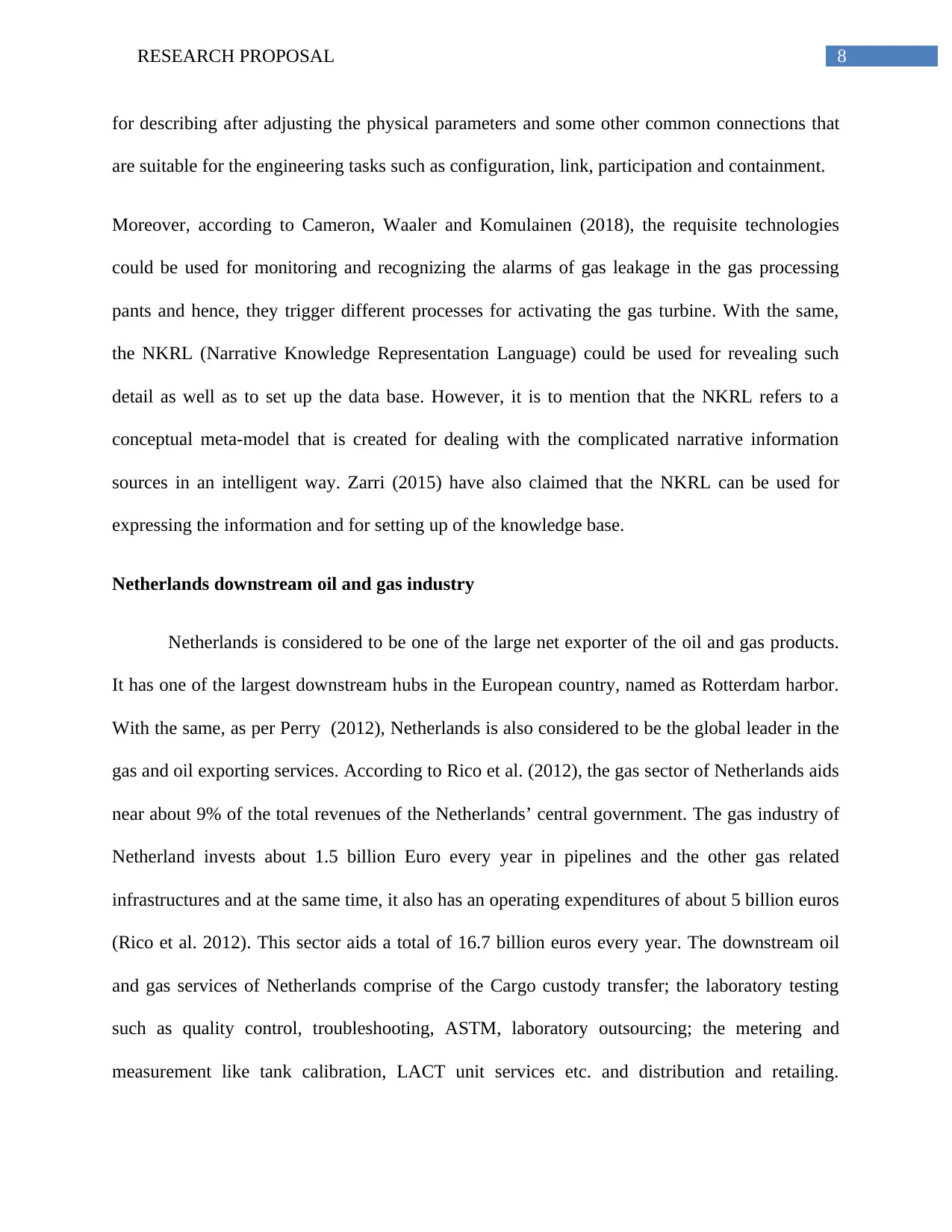
8RESEARCH PROPOSAL
for describing after adjusting the physical parameters and some other common connections that
are suitable for the engineering tasks such as configuration, link, participation and containment.
Moreover, according to Cameron, Waaler and Komulainen (2018), the requisite technologies
could be used for monitoring and recognizing the alarms of gas leakage in the gas processing
pants and hence, they trigger different processes for activating the gas turbine. With the same,
the NKRL (Narrative Knowledge Representation Language) could be used for revealing such
detail as well as to set up the data base. However, it is to mention that the NKRL refers to a
conceptual meta-model that is created for dealing with the complicated narrative information
sources in an intelligent way. Zarri (2015) have also claimed that the NKRL can be used for
expressing the information and for setting up of the knowledge base.
Netherlands downstream oil and gas industry
Netherlands is considered to be one of the large net exporter of the oil and gas products.
It has one of the largest downstream hubs in the European country, named as Rotterdam harbor.
With the same, as per Perry (2012), Netherlands is also considered to be the global leader in the
gas and oil exporting services. According to Rico et al. (2012), the gas sector of Netherlands aids
near about 9% of the total revenues of the Netherlands’ central government. The gas industry of
Netherland invests about 1.5 billion Euro every year in pipelines and the other gas related
infrastructures and at the same time, it also has an operating expenditures of about 5 billion euros
(Rico et al. 2012). This sector aids a total of 16.7 billion euros every year. The downstream oil
and gas services of Netherlands comprise of the Cargo custody transfer; the laboratory testing
such as quality control, troubleshooting, ASTM, laboratory outsourcing; the metering and
measurement like tank calibration, LACT unit services etc. and distribution and retailing.
for describing after adjusting the physical parameters and some other common connections that
are suitable for the engineering tasks such as configuration, link, participation and containment.
Moreover, according to Cameron, Waaler and Komulainen (2018), the requisite technologies
could be used for monitoring and recognizing the alarms of gas leakage in the gas processing
pants and hence, they trigger different processes for activating the gas turbine. With the same,
the NKRL (Narrative Knowledge Representation Language) could be used for revealing such
detail as well as to set up the data base. However, it is to mention that the NKRL refers to a
conceptual meta-model that is created for dealing with the complicated narrative information
sources in an intelligent way. Zarri (2015) have also claimed that the NKRL can be used for
expressing the information and for setting up of the knowledge base.
Netherlands downstream oil and gas industry
Netherlands is considered to be one of the large net exporter of the oil and gas products.
It has one of the largest downstream hubs in the European country, named as Rotterdam harbor.
With the same, as per Perry (2012), Netherlands is also considered to be the global leader in the
gas and oil exporting services. According to Rico et al. (2012), the gas sector of Netherlands aids
near about 9% of the total revenues of the Netherlands’ central government. The gas industry of
Netherland invests about 1.5 billion Euro every year in pipelines and the other gas related
infrastructures and at the same time, it also has an operating expenditures of about 5 billion euros
(Rico et al. 2012). This sector aids a total of 16.7 billion euros every year. The downstream oil
and gas services of Netherlands comprise of the Cargo custody transfer; the laboratory testing
such as quality control, troubleshooting, ASTM, laboratory outsourcing; the metering and
measurement like tank calibration, LACT unit services etc. and distribution and retailing.
⊘ This is a preview!⊘
Do you want full access?
Subscribe today to unlock all pages.

Trusted by 1+ million students worldwide
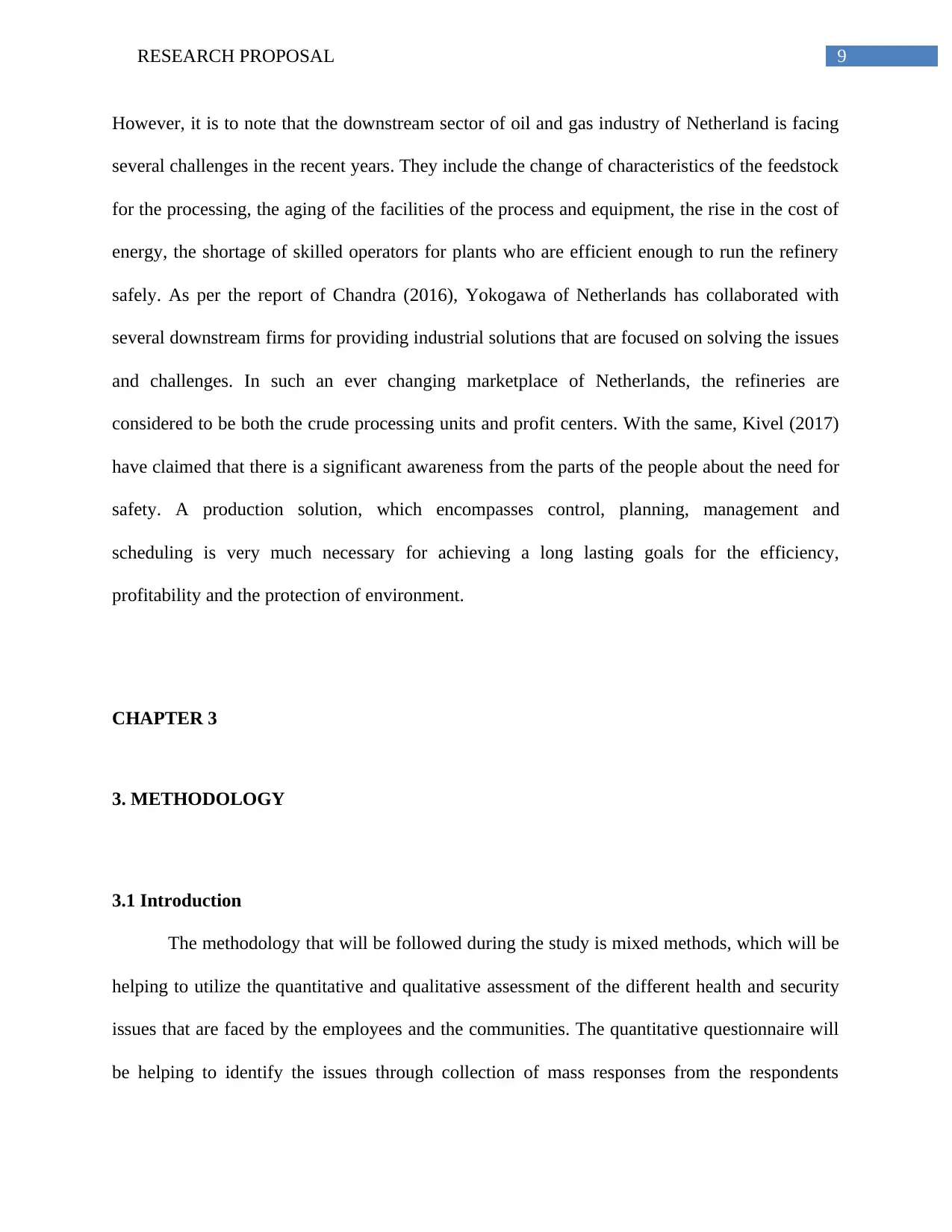
9RESEARCH PROPOSAL
However, it is to note that the downstream sector of oil and gas industry of Netherland is facing
several challenges in the recent years. They include the change of characteristics of the feedstock
for the processing, the aging of the facilities of the process and equipment, the rise in the cost of
energy, the shortage of skilled operators for plants who are efficient enough to run the refinery
safely. As per the report of Chandra (2016), Yokogawa of Netherlands has collaborated with
several downstream firms for providing industrial solutions that are focused on solving the issues
and challenges. In such an ever changing marketplace of Netherlands, the refineries are
considered to be both the crude processing units and profit centers. With the same, Kivel (2017)
have claimed that there is a significant awareness from the parts of the people about the need for
safety. A production solution, which encompasses control, planning, management and
scheduling is very much necessary for achieving a long lasting goals for the efficiency,
profitability and the protection of environment.
CHAPTER 3
3. METHODOLOGY
3.1 Introduction
The methodology that will be followed during the study is mixed methods, which will be
helping to utilize the quantitative and qualitative assessment of the different health and security
issues that are faced by the employees and the communities. The quantitative questionnaire will
be helping to identify the issues through collection of mass responses from the respondents
However, it is to note that the downstream sector of oil and gas industry of Netherland is facing
several challenges in the recent years. They include the change of characteristics of the feedstock
for the processing, the aging of the facilities of the process and equipment, the rise in the cost of
energy, the shortage of skilled operators for plants who are efficient enough to run the refinery
safely. As per the report of Chandra (2016), Yokogawa of Netherlands has collaborated with
several downstream firms for providing industrial solutions that are focused on solving the issues
and challenges. In such an ever changing marketplace of Netherlands, the refineries are
considered to be both the crude processing units and profit centers. With the same, Kivel (2017)
have claimed that there is a significant awareness from the parts of the people about the need for
safety. A production solution, which encompasses control, planning, management and
scheduling is very much necessary for achieving a long lasting goals for the efficiency,
profitability and the protection of environment.
CHAPTER 3
3. METHODOLOGY
3.1 Introduction
The methodology that will be followed during the study is mixed methods, which will be
helping to utilize the quantitative and qualitative assessment of the different health and security
issues that are faced by the employees and the communities. The quantitative questionnaire will
be helping to identify the issues through collection of mass responses from the respondents
Paraphrase This Document
Need a fresh take? Get an instant paraphrase of this document with our AI Paraphraser
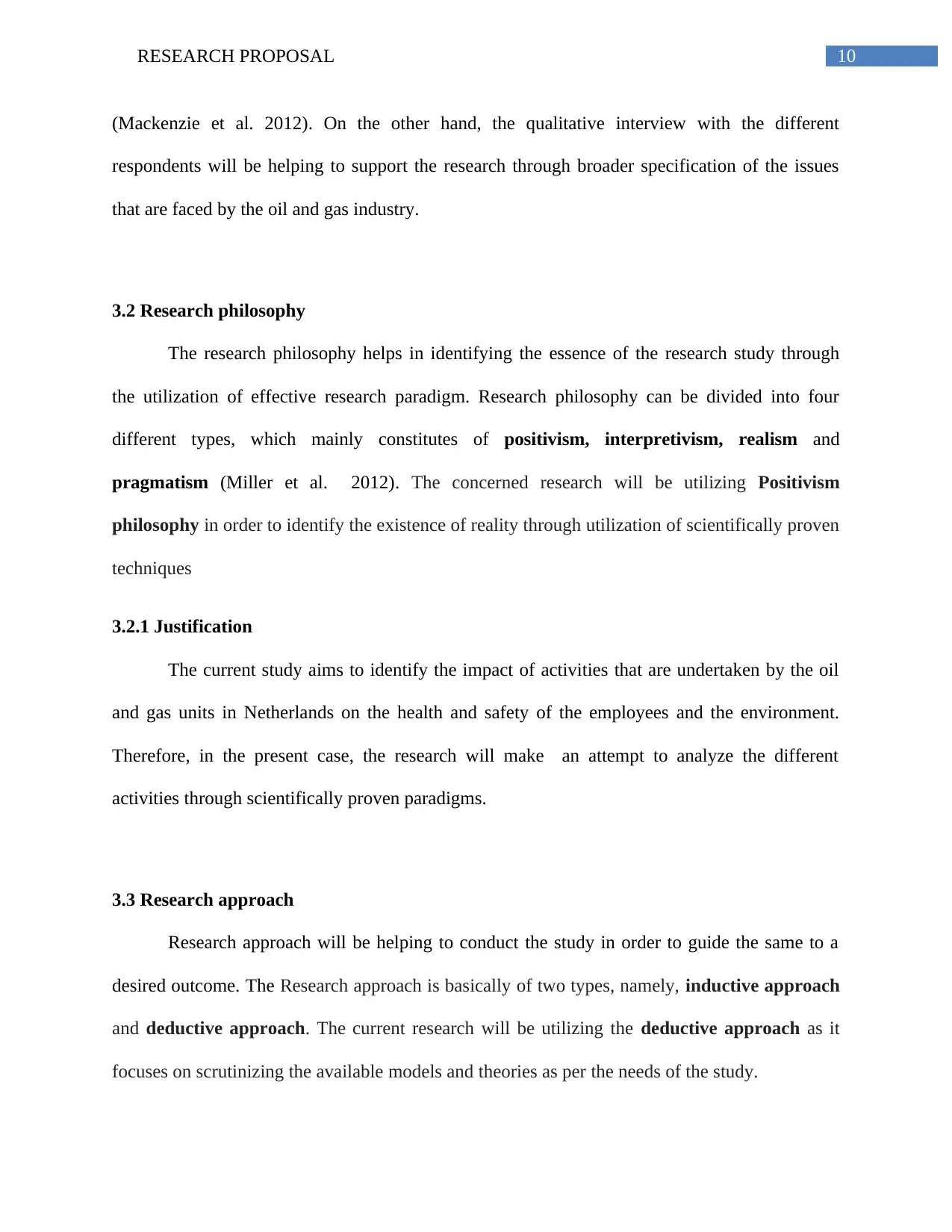
10RESEARCH PROPOSAL
(Mackenzie et al. 2012). On the other hand, the qualitative interview with the different
respondents will be helping to support the research through broader specification of the issues
that are faced by the oil and gas industry.
3.2 Research philosophy
The research philosophy helps in identifying the essence of the research study through
the utilization of effective research paradigm. Research philosophy can be divided into four
different types, which mainly constitutes of positivism, interpretivism, realism and
pragmatism (Miller et al. 2012). The concerned research will be utilizing Positivism
philosophy in order to identify the existence of reality through utilization of scientifically proven
techniques
3.2.1 Justification
The current study aims to identify the impact of activities that are undertaken by the oil
and gas units in Netherlands on the health and safety of the employees and the environment.
Therefore, in the present case, the research will make an attempt to analyze the different
activities through scientifically proven paradigms.
3.3 Research approach
Research approach will be helping to conduct the study in order to guide the same to a
desired outcome. The Research approach is basically of two types, namely, inductive approach
and deductive approach. The current research will be utilizing the deductive approach as it
focuses on scrutinizing the available models and theories as per the needs of the study.
(Mackenzie et al. 2012). On the other hand, the qualitative interview with the different
respondents will be helping to support the research through broader specification of the issues
that are faced by the oil and gas industry.
3.2 Research philosophy
The research philosophy helps in identifying the essence of the research study through
the utilization of effective research paradigm. Research philosophy can be divided into four
different types, which mainly constitutes of positivism, interpretivism, realism and
pragmatism (Miller et al. 2012). The concerned research will be utilizing Positivism
philosophy in order to identify the existence of reality through utilization of scientifically proven
techniques
3.2.1 Justification
The current study aims to identify the impact of activities that are undertaken by the oil
and gas units in Netherlands on the health and safety of the employees and the environment.
Therefore, in the present case, the research will make an attempt to analyze the different
activities through scientifically proven paradigms.
3.3 Research approach
Research approach will be helping to conduct the study in order to guide the same to a
desired outcome. The Research approach is basically of two types, namely, inductive approach
and deductive approach. The current research will be utilizing the deductive approach as it
focuses on scrutinizing the available models and theories as per the needs of the study.
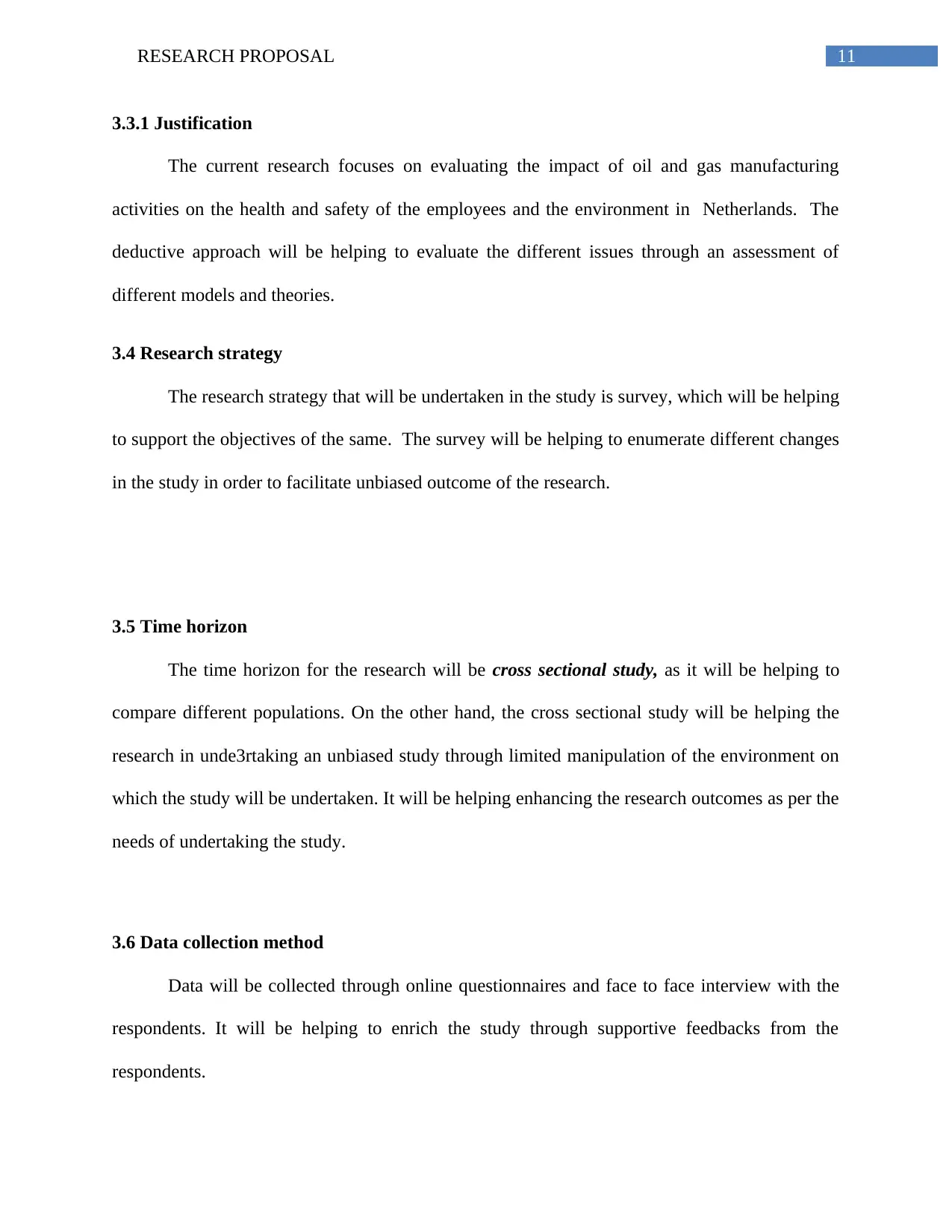
11RESEARCH PROPOSAL
3.3.1 Justification
The current research focuses on evaluating the impact of oil and gas manufacturing
activities on the health and safety of the employees and the environment in Netherlands. The
deductive approach will be helping to evaluate the different issues through an assessment of
different models and theories.
3.4 Research strategy
The research strategy that will be undertaken in the study is survey, which will be helping
to support the objectives of the same. The survey will be helping to enumerate different changes
in the study in order to facilitate unbiased outcome of the research.
3.5 Time horizon
The time horizon for the research will be cross sectional study, as it will be helping to
compare different populations. On the other hand, the cross sectional study will be helping the
research in unde3rtaking an unbiased study through limited manipulation of the environment on
which the study will be undertaken. It will be helping enhancing the research outcomes as per the
needs of undertaking the study.
3.6 Data collection method
Data will be collected through online questionnaires and face to face interview with the
respondents. It will be helping to enrich the study through supportive feedbacks from the
respondents.
3.3.1 Justification
The current research focuses on evaluating the impact of oil and gas manufacturing
activities on the health and safety of the employees and the environment in Netherlands. The
deductive approach will be helping to evaluate the different issues through an assessment of
different models and theories.
3.4 Research strategy
The research strategy that will be undertaken in the study is survey, which will be helping
to support the objectives of the same. The survey will be helping to enumerate different changes
in the study in order to facilitate unbiased outcome of the research.
3.5 Time horizon
The time horizon for the research will be cross sectional study, as it will be helping to
compare different populations. On the other hand, the cross sectional study will be helping the
research in unde3rtaking an unbiased study through limited manipulation of the environment on
which the study will be undertaken. It will be helping enhancing the research outcomes as per the
needs of undertaking the study.
3.6 Data collection method
Data will be collected through online questionnaires and face to face interview with the
respondents. It will be helping to enrich the study through supportive feedbacks from the
respondents.
⊘ This is a preview!⊘
Do you want full access?
Subscribe today to unlock all pages.

Trusted by 1+ million students worldwide
1 out of 18
Related Documents
Your All-in-One AI-Powered Toolkit for Academic Success.
+13062052269
info@desklib.com
Available 24*7 on WhatsApp / Email
![[object Object]](/_next/static/media/star-bottom.7253800d.svg)
Unlock your academic potential
Copyright © 2020–2025 A2Z Services. All Rights Reserved. Developed and managed by ZUCOL.





